illinois
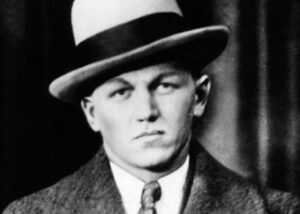 Lester Joseph Gillis may have had a baby face, but he was no innocent. The fact is that he seldom went by his real name. His alias was George Nelson and Baby Face Nelson. While he had a baby face, he was not a nice man, in fact, he was a cold-hearted killer, known for killing more FBI agents than any other criminal. Gillis was born in the Patch area of Chicago, Illinois on December 6, 1908. He was the seventh child of Belgian immigrants, Joseph and Mary Gillis. His father was a hardworking man, who worked in a tannery. Joseph strived to raise a loving family…but, somehow, with Lester, that proper upbringing didn’t work out so well. Lester’s first arrest occurred on July 4, 1921, at the age of twelve. In that incident, he accidentally shot a playmate in the jaw with a pistol that he had found. The situation was serious enough, that he served over a year in the state reformatory. When he got out at age 13, Nelson was quickly arrested again for car theft and joyriding at age 13. He was sent to a correctional school for an additional 18 months and released on April 11, 1924. Gillis’ family was horrified at his behavior, but Gillis was “on a roll” by then, and he didn’t care. He liked the “excitement” that a life of crime provided, and he wasn’t about to quit.
Lester Joseph Gillis may have had a baby face, but he was no innocent. The fact is that he seldom went by his real name. His alias was George Nelson and Baby Face Nelson. While he had a baby face, he was not a nice man, in fact, he was a cold-hearted killer, known for killing more FBI agents than any other criminal. Gillis was born in the Patch area of Chicago, Illinois on December 6, 1908. He was the seventh child of Belgian immigrants, Joseph and Mary Gillis. His father was a hardworking man, who worked in a tannery. Joseph strived to raise a loving family…but, somehow, with Lester, that proper upbringing didn’t work out so well. Lester’s first arrest occurred on July 4, 1921, at the age of twelve. In that incident, he accidentally shot a playmate in the jaw with a pistol that he had found. The situation was serious enough, that he served over a year in the state reformatory. When he got out at age 13, Nelson was quickly arrested again for car theft and joyriding at age 13. He was sent to a correctional school for an additional 18 months and released on April 11, 1924. Gillis’ family was horrified at his behavior, but Gillis was “on a roll” by then, and he didn’t care. He liked the “excitement” that a life of crime provided, and he wasn’t about to quit.
By the time he met his wife, Helen Wawrzyniak, Gillis (Baby Face Nelson) was working at a Standard Oil station in his neighborhood. Of course, that job wasn’t what it seemed either. The station doubled as the headquarters for a group of young tire thieves, known as “strippers” and Nelson fell into association with them. Through that association, Nelson acquainted himself with a number of local criminals. One of those criminals employed him to drive bootleg alcohol throughout the Chicago suburbs. Nelson quickly became a known member of the suburb-based Touhy Gang. All this happened by the time he was in his mid-teens. Very soon he became the Touhy Gang’s leader. In 1928, he married Helen Wawrzyniak, and they had two children, but that didn’t change his “bad boy ways” either. Within two years, Nelson and the gang were involved in organized crime, especially armed robbery. On January 6, 1930, the associates forced entry into the home of magazine executive Charles M Richter. After securing him up with adhesive tape and cutting the phone lines, they ransacked the house and made off with approximately $205,000 worth of jewelry, which would figure to approximately $3.3 million in 2021 dollars. Just two months later, they carried out a similar robbery at the bungalow of Lottie Brenner Von Buelow on Sheridan Road. This job netted approximately $50,000 worth of jewelry. After the crime, Chicago newspapers dubbed the gang, “The Tape Bandits.”
On April 21, 1930, Nelson and his gang robbed a bank for the first time. That take could hardly be considered 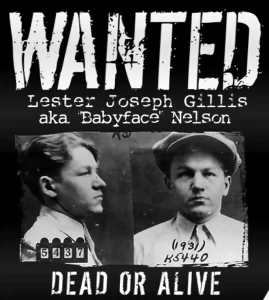 successful, at a mere $4,000. A month later, he and his gang netted $25,000 worth of jewelry from home invasions. On October 3, 1930, Nelson robbed the Itasca State Bank of $4,600…another disappointing take, and an even bigger problem, when a teller later identified him as one of the robbers. Three nights later, he brazenly stole the jewelry of the wife of Chicago mayor Big Bill Thompson, valued at $18,000. She also described her attacker, saying “He had a baby face. He was good looking, hardly more than a boy, had dark hair and was wearing a gray topcoat and a brown felt hat, turned down brim.” The net was beginning to close around Nelson. Then, he and his crew were linked to a botched roadhouse robbery in Summit, Illinois, on November 23, 1930.In the ensuing gunfight, three people were killed and three wounded. One might think that Nelson would lay low for a while, but three nights later, Nelson’s gang robbed a tavern on Waukegan Road, and Nelson committed his first murder, when he fatally shot stockbroker Edwin R Thompson.
successful, at a mere $4,000. A month later, he and his gang netted $25,000 worth of jewelry from home invasions. On October 3, 1930, Nelson robbed the Itasca State Bank of $4,600…another disappointing take, and an even bigger problem, when a teller later identified him as one of the robbers. Three nights later, he brazenly stole the jewelry of the wife of Chicago mayor Big Bill Thompson, valued at $18,000. She also described her attacker, saying “He had a baby face. He was good looking, hardly more than a boy, had dark hair and was wearing a gray topcoat and a brown felt hat, turned down brim.” The net was beginning to close around Nelson. Then, he and his crew were linked to a botched roadhouse robbery in Summit, Illinois, on November 23, 1930.In the ensuing gunfight, three people were killed and three wounded. One might think that Nelson would lay low for a while, but three nights later, Nelson’s gang robbed a tavern on Waukegan Road, and Nelson committed his first murder, when he fatally shot stockbroker Edwin R Thompson.
Throughout the winter of 1931, most of the “Tape Bandits” were rounded up, including Nelson. The Chicago Tribune referred to their leader as “George ‘Baby Face’ Nelson” who received a sentence of one year to life in the state penitentiary at Joliet. Refusing to be held, Nelson escaped during a prison transfer in February 1932. Through his contacts within the Touhy Gang, Nelson fled west to Reno, where he was harbored by William Graham, a known crime boss and gambler. He began using the alias “Jimmy Johnson” at this point. Nelson…now Johnson went to Sausalito, California, where he worked for bootlegger Joe Parente.
Nelson decided that it was time for him to have a gang of his own after the Grand Haven bank robbery. Nelson used his connections at the Green Lantern Tavern in Saint Paul, to recruit Homer Van Meter, Tommy Carroll, and Eddie Green. With his new gang, and with the addition of two other local thieves, Nelson robbed the First National Bank of Brainerd, Minnesota on October 23, 1933. The take on that robbery was $32,000, or approximately $670,000 in 2021 dollars. It was reported that Nelson wildly sprayed sub-machine gun bullets at bystanders to facilitate his getaway. Then, he picked up his wife, Helen and four-year-old son Ronald, and left with his crew for San Antonio, Texas. In San Antonia, he and his gang bought several weapons from a crooked gunsmith Hyman Lehman, one of which was a .38 Super Colt pistol that had been modified, so it was fully automatic. That gun was used by Nelson to kill Special Agent W Carter Baum at Little Bohemia Lodge several months later.
On December 9, 1933, a local woman tipped off San Antonio police regarding “high-powered Northern gangsters” in the area. Tommy Carroll was cornered two days later by two detectives who opened fire, killing Detective H.C. Perrin and wounding Detective Al Hartman. At that point, the gang split up with all the Nelson gang, except Nelson, leaving San Antonio. As a way to distance himself from the gang, Nelson and his wife traveled west to the San Francisco Bay Area. The prior close call didn’t slow him down, however. In San Francisco, he recruited John Paul Chase and Fatso Negri for a new wave of bank robberies the following spring. The next winter found him in Reno, where he met the vacationing, Alvin Karpis. Karpis introduced him to Midwestern bank robber Eddie Bentz. Teaming up with Bentz, Nelson returned to the Midwest the next summer.  On August 18, 1933, Nelson committed a major bank robbery in Grand Haven, Michigan. It was his first robbery in the area. The robbery was pretty much a failure…but it was a successful failure, because most of those involved made a full escape.
On August 18, 1933, Nelson committed a major bank robbery in Grand Haven, Michigan. It was his first robbery in the area. The robbery was pretty much a failure…but it was a successful failure, because most of those involved made a full escape.
Gillis Helped John Dillinger escape from prison in Crown Point, Indiana, and then became his partner. Nelson and the Touhy Gang were collectively “Public Enemy Number One” by the FBI. The alias, “Baby Face Nelson” came from Gillis being a short man with a youthful appearance. Still, in the professional realm, Gillis’ fellow criminals addressed him as “Jimmy.” On November 27, 1934, FBI agents fatally wounded and killed Baby Face Nelson in the Battle of Barrington, which was fought in a suburb of Chicago, Illinois.
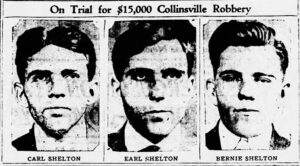 During the Prohibition-era there were many people who opposed the new laws prohibiting the sale and manufacturing of alcohol, in any form. As with any such restriction, there were plenty of people who were willing to take matters into their own hands and make, in this case, illegal liquor. It was a profitable business, and there were a number of people and gangs who wanted in. The Shelton Brothers Gang had a good thing going, when the famous bootlegger, Charles Birger and his gang wanted in.
During the Prohibition-era there were many people who opposed the new laws prohibiting the sale and manufacturing of alcohol, in any form. As with any such restriction, there were plenty of people who were willing to take matters into their own hands and make, in this case, illegal liquor. It was a profitable business, and there were a number of people and gangs who wanted in. The Shelton Brothers Gang had a good thing going, when the famous bootlegger, Charles Birger and his gang wanted in.
The Shelton Brothers Gang had other ideas, however. Both gangs were based out of southern Illinois. The best way to control the market price, is to be the only game in town. With all the fighting for supremacy, the Shelton Brothers Gang would allegedly be known as “America’s Bloodiest Gang” when the fighting quickly became a “Turf War.” The Shelton Brothers Gang was formed by Carl (born 1888), Earl (born 1890), and Bernie “Red” Shelton (born 1898) of “Geff” Jeffersonville, Wayne County, Illinois. They started their gang shortly after Prohibition came into effect in 1920, operating mostly in Williamson County, Illinois, making moonshine and other illegal alcoholic beverages. The operation grew, and they eventually dominated both gambling and liquor distribution in Little Egypt until 1926. That’s when a former ally now turned nemesis, gangster Charles Birger, attempted to take over 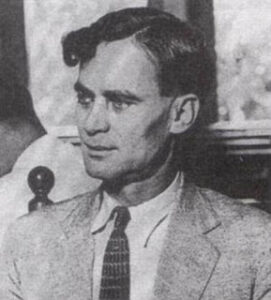 the Sheltons’ bootlegging operations. The result was a violent gang war. The weapons were varied. Both sides use homemade armored trucks and included an eventually included an aerial bombing raid by the Sheltons on Birger’s Shady Rest headquarters. They were out of control, and with the “stepped-up attacks” came what was considered the first bombing from a plane on US soil. Strangely, the “Turf War” was also responsible for keeping the KKK out of their general area after the constant flare ups into fights. The battle was for the control of bootlegging in all of southern Illinois and nothing more.
the Sheltons’ bootlegging operations. The result was a violent gang war. The weapons were varied. Both sides use homemade armored trucks and included an eventually included an aerial bombing raid by the Sheltons on Birger’s Shady Rest headquarters. They were out of control, and with the “stepped-up attacks” came what was considered the first bombing from a plane on US soil. Strangely, the “Turf War” was also responsible for keeping the KKK out of their general area after the constant flare ups into fights. The battle was for the control of bootlegging in all of southern Illinois and nothing more.
The whole thing was brutal in every way, and finally, the Shelton Brothers were set up and blamed for a murder they did not commit. Based on the testimony of Birger and Art Newman, the Shelton Brothers were convicted of an unsolved 1925 mail carrier robbery of $15,000 and sentenced to 25 years in prison, but they were later released. In the meantime, without its leaders, the Shelton Brothers Gang slowly faded, and just as he had planned, Birger dominated bootlegging in Southern Illinois, until he was hanged in 1928 after being convicted of ordering the murder of West City, Illinois, Mayor Joe Adams, who was a Shelton supporter. Eventually, the Shelton Brothers Gang was released for lack of evidence against them. The decided to move the operation to Peoria, Illinois, and focus mainly on gambling. They built an alliance with known gangsters like Al Capone and  dominated their territory with very few serious rivalries. They did, however, come to the attention of the Federal Officials who eventually placed a $15,000 bounty on each of the Sheltons heads. Carl and Bernie Shelton were both murdered in 1948, on orders from former gang member Frank “Buster” Wortman, who had taken over the Shelton operations while they were in prison. Worman dominated Saint Louis’ illegal gambling and other criminal activities until his death in 1968. Earl Shelton was also ambushed and shot, but he survived. The hits just kept coming, and after a third attempt on his life in the early 1950s, Earl and his family left Illinois for Florida. Earl lived a quiet life there, and in 1986 at age 96, he passed away. He was the last member of the Shelton Brothers Gang.
dominated their territory with very few serious rivalries. They did, however, come to the attention of the Federal Officials who eventually placed a $15,000 bounty on each of the Sheltons heads. Carl and Bernie Shelton were both murdered in 1948, on orders from former gang member Frank “Buster” Wortman, who had taken over the Shelton operations while they were in prison. Worman dominated Saint Louis’ illegal gambling and other criminal activities until his death in 1968. Earl Shelton was also ambushed and shot, but he survived. The hits just kept coming, and after a third attempt on his life in the early 1950s, Earl and his family left Illinois for Florida. Earl lived a quiet life there, and in 1986 at age 96, he passed away. He was the last member of the Shelton Brothers Gang.
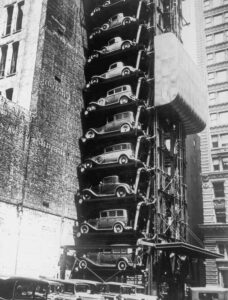 In 1932 Chicago was a city that was on the cutting edge of things, including car ownership. It wasn’t that everyone owned a car, but enough people did that there was beginning to be congestion problem where parking is concerned. It was especially bad for apartment buildings in the city. the people owned a car, but now they had to park so far away that they might as well not own a car. If they weren’t the first one home, they didn’t get to park close.
In 1932 Chicago was a city that was on the cutting edge of things, including car ownership. It wasn’t that everyone owned a car, but enough people did that there was beginning to be congestion problem where parking is concerned. It was especially bad for apartment buildings in the city. the people owned a car, but now they had to park so far away that they might as well not own a car. If they weren’t the first one home, they didn’t get to park close.
Enter the Car Parking Machine. Built by Westinghouse Electric and Manufacturing Company, the system took up the space of six cars at its base, but it held 48 cars. There are numerous compartments in the machine, and they are moving constantly in a vertical direction, like a car elevator. The system was run by an attendant, and when 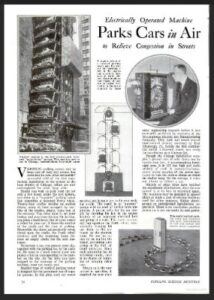 they put a car in a slot, the machine moved it to the next open slot. When the car owner wanted his car back, the attendant rotated the structure until the right car was down, and then backed the car out for the owner, just to be safe.
they put a car in a slot, the machine moved it to the next open slot. When the car owner wanted his car back, the attendant rotated the structure until the right car was down, and then backed the car out for the owner, just to be safe.
The system was such a new phenomenon that they even came out with a short film about it called ‘Vertical Auto Park Solves Problem of Windy City.’ The film shows cars being driven in cages on conveyors that rise in a Ferris Wheel like manner. People look on as cars are carried by a 105-foot-high elevator that parks 48 cars in an area of 16 by 24 feet. It was filmed on location in Chicago, Illinois and aired on April 25, 1932. The Vertical Automatic Parking Lot was actually first tested in East Pittsburgh, Pennsylvania  before being set up as a commercial enterprise in the Chicago Loop during 1932.
before being set up as a commercial enterprise in the Chicago Loop during 1932.
While the system is really quite old, it isn’t necessarily out of date. For example, look at the latest way to buy a car…Carvana. While the purpose of the elevator system is different, the idea is still the same. You find your car online, and then you can go to the car vending machine to get your car. Just like the old system, your car takes a ride in the elevator to get to you. When you think about it, the system was a good one, and should probably be used in more places. Parking congestion is an ongoing problem, after all.

 These days, people can buy a ticket to ride a train and have a private room with a bed and bathroom in it to make their trip more comfortable. Since I have taken a train trip from Seattle, Washington to Chicago, Illinois, I can tell you that paying the extra money for that private cabin is really a good idea. We traveled in in a seat among the other passengers, and while the seat was pretty comfortable, it was not comfortable to sleep in. My parents traveled on the Amtrack too, and they did get a private cabin, so their experience was probably much better than mine, although I loved the trip…just not the sleeping part of it. Of course, even with the comfort my parents had on
These days, people can buy a ticket to ride a train and have a private room with a bed and bathroom in it to make their trip more comfortable. Since I have taken a train trip from Seattle, Washington to Chicago, Illinois, I can tell you that paying the extra money for that private cabin is really a good idea. We traveled in in a seat among the other passengers, and while the seat was pretty comfortable, it was not comfortable to sleep in. My parents traveled on the Amtrack too, and they did get a private cabin, so their experience was probably much better than mine, although I loved the trip…just not the sleeping part of it. Of course, even with the comfort my parents had on 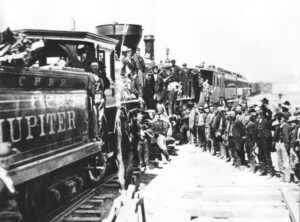 their trip, it was nothing compared to the Gilded Age, when the very rich had their own car on the train.
their trip, it was nothing compared to the Gilded Age, when the very rich had their own car on the train.
The Gilded Age was a time when the very rich went to great lengths to let all of the “less fortunate ones” know that they had wealth. The Gilded Age took place mostly from 1887 to 1900, with some earlier exceptions. One of the main objectives of life during the Gilded Age, if one could afford it, was to see and be seen in the most luxurious ways possible, and the railway was no different. Commercial air travel didn’t exist then, and cars were very slow. So, when the nation came into the age of the rails, the wealthy made sure that extreme luxury there was no exception. By the 1870s, private railroad cars…some extravagantly decorated…were the most fashionable way to travel. I suppose it would have been like the very 
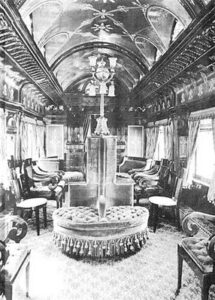 rich on ships, but they could stay a little closer to home, and still travel. The people would never travel in humble wooden coach seats, which I can understand, but most people had no other choice. Money bought comfort.
rich on ships, but they could stay a little closer to home, and still travel. The people would never travel in humble wooden coach seats, which I can understand, but most people had no other choice. Money bought comfort.
With great fanfare, the very rich boarded their own entire rail cars, where the walls were lined in velvet, the upholstery plush, and the decor much like that of a fancy parlor at home. The private cars had bedrooms, running water, and a private water closet. Now expense was spared to make sure that the wealthy car owner was never out of the lap of luxury. It seems like a cruel way to act, but I suppose it is simply the way it is.
 Nurses are the cornerstone of medicine in many cases. Yes, we must have doctors, but nurses are the support system that allows doctors to do their jobs. One such example was a woman named Mary Ann Bickerdyke. She was born on July 19, 1817 in Knox County, Ohio, to Hiram and Annie (Rodgers) Ball. She was married in 1847 to Robert Bickerdyke. The couple and their family moved to Galesburg, Illinois. After her infant daughter died suddenly, she vowed to learn more about medicine, studying herbal medicine at Oberlin College. Mary Ann was widowed in 1859. She was alone and the mother of two sons, who were in their adolescent years.
Nurses are the cornerstone of medicine in many cases. Yes, we must have doctors, but nurses are the support system that allows doctors to do their jobs. One such example was a woman named Mary Ann Bickerdyke. She was born on July 19, 1817 in Knox County, Ohio, to Hiram and Annie (Rodgers) Ball. She was married in 1847 to Robert Bickerdyke. The couple and their family moved to Galesburg, Illinois. After her infant daughter died suddenly, she vowed to learn more about medicine, studying herbal medicine at Oberlin College. Mary Ann was widowed in 1859. She was alone and the mother of two sons, who were in their adolescent years.
Widowed just two years before the Civil War began, she supported herself and her sons by practicing as a “botanic physician” in Galesburg. When a young Union volunteer physician wrote home about the filthy, chaotic military hospitals at Cairo, Illinois, the citizens of Galesburg collected $500 worth of supplies and selected Bickerdyke to deliver them. She left her sons with a neighbor, and after seeing the horrible conditions for herself, Bickerdyke decided that she was needed there, so she stayed as an unofficial nurse. Her never ending energy, and her dedication made her just the heroine the Union soldiers needed in those awful war years. She organized the hospitals and cleaned up the filth that served only to breed germs, and in doing so, she gained the respect and appreciation of Ulysses S. Grant.
While there, she worked alongside another famed Civil War Nurse, Mary J. Stafford. When Grant’s army moved down the Mississippi River, Bickerdyke went too, becoming the Chief of Nursing and setting up hospitals where 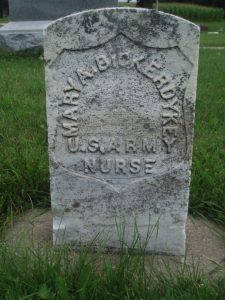 they were needed. Bickerdyke’s goal during the Civil War was to more efficiently care for wounded Union soldiers. She insisted on cleanliness, was dedicated to improving the level of care, and unafraid of stepping on male toes. That, in itself, was almost unheard of in that era. She was adamant about scrubbing every surface in sight, reported drunken physicians, and on one occasion ordered a staff member, who had illegally appropriated garments meant for the wounded, to strip. Though she antagonized male physicians, staff, and soldiers alike, in the name of better patient care, she won most of her battles…a good thing for the wounded soldiers.
they were needed. Bickerdyke’s goal during the Civil War was to more efficiently care for wounded Union soldiers. She insisted on cleanliness, was dedicated to improving the level of care, and unafraid of stepping on male toes. That, in itself, was almost unheard of in that era. She was adamant about scrubbing every surface in sight, reported drunken physicians, and on one occasion ordered a staff member, who had illegally appropriated garments meant for the wounded, to strip. Though she antagonized male physicians, staff, and soldiers alike, in the name of better patient care, she won most of her battles…a good thing for the wounded soldiers.
Union General William T. Sherman was especially fond of the volunteer nurse who followed the western armies. It is said that she was the only woman he would allow in his camp. When his staff complained about the outspoken, insubordinate female nurse who constantly disregarded the army’s red tape and military procedures, Sherman threw up his hands and exclaimed, “Well, I can do nothing for you, she outranks me.” Running roughshod over anyone who stood in the way of her self-appointed duties, when a surgeon questioned her authority to take some action, she replied, “On the authority of Lord God Almighty, have you anything that outranks that?” I guess Sherman was right when he said that she outranked him.
To the wounded soldiers, Bickerdyke was an angel. They affectionately called her “Mother” Bickerdyke, and she called them her “boys.” The soldiers would cheer here when she appeared. She was more loved than the celebrities of our day are for some fans. During the war, she worked closely with Eliza Emily Chappell Porter of the Northwest Sanitary Commission, worked on the first hospital boat, helped build 300 hospitals and aided the wounded on 19 battlefields including the Battle of Shiloh, the Battle of Vicksburg, and Sherman’s March to the 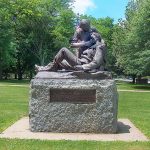 Sea. When the war was over, she rode at the head of the XV Corps in the Grand Review in Washington at General William T. Sherman’s request. Afterwards, she worked for the Salvation Army in San Francisco, and became an attorney, helping Union veterans with legal issues. Later, she ran a hotel in Salina, Kansas for a time before retiring to Bunker Hill, Kansas. She received a special pension of $25 a month from Congress in 1886. She died peacefully after a minor stroke November 8, 1901. Her remains were transported back to Galesburg, Illinois and she was interred next to her husband at the Linwood Cemetery. In memory of Bickerdyke’s selflessness, a statue of her was erected in Galesburg, Illinois. Two ships…a hospital boat, a liberty ship, and a cemetery in Kansas were named after her.
Sea. When the war was over, she rode at the head of the XV Corps in the Grand Review in Washington at General William T. Sherman’s request. Afterwards, she worked for the Salvation Army in San Francisco, and became an attorney, helping Union veterans with legal issues. Later, she ran a hotel in Salina, Kansas for a time before retiring to Bunker Hill, Kansas. She received a special pension of $25 a month from Congress in 1886. She died peacefully after a minor stroke November 8, 1901. Her remains were transported back to Galesburg, Illinois and she was interred next to her husband at the Linwood Cemetery. In memory of Bickerdyke’s selflessness, a statue of her was erected in Galesburg, Illinois. Two ships…a hospital boat, a liberty ship, and a cemetery in Kansas were named after her.
 For many years, levee systems were built along rivers to hold back flood waters. They work very well…until they don’t. When a levee ruptures, the resulting flood is usually devastating. From June through August of 1993, the midwestern United States received an unusually large amount of rain…far more than normal. The rain led to severe flooding, particularly along the Illinois and Missouri shores. Then, on July 22, 1993, the levee holding back the flooding Mississippi River at Kaskaskia, Illinois, ruptured. The town’s people were forced to flee on barges. In all, more than 1,000 levees burst in late July, but, the incident at Kaskaskia was the most dramatic event of the flood. The town, which was virtually an island, was protected by a levee that the town attempted to shore up even after the bridge connecting the town to the riverside was wiped out by the rising river. At
For many years, levee systems were built along rivers to hold back flood waters. They work very well…until they don’t. When a levee ruptures, the resulting flood is usually devastating. From June through August of 1993, the midwestern United States received an unusually large amount of rain…far more than normal. The rain led to severe flooding, particularly along the Illinois and Missouri shores. Then, on July 22, 1993, the levee holding back the flooding Mississippi River at Kaskaskia, Illinois, ruptured. The town’s people were forced to flee on barges. In all, more than 1,000 levees burst in late July, but, the incident at Kaskaskia was the most dramatic event of the flood. The town, which was virtually an island, was protected by a levee that the town attempted to shore up even after the bridge connecting the town to the riverside was wiped out by the rising river. At  9:48am, the levee broke, leaving the people of Kaskaskia with no escape route other than two Army Corp of Engineers barges. By 2pm, the entire town was underwater.
9:48am, the levee broke, leaving the people of Kaskaskia with no escape route other than two Army Corp of Engineers barges. By 2pm, the entire town was underwater.
The rupture of the levee at Quincy, Illinois, left no way to cross the Mississippi River for 250 miles north of Saint Louis. In Grafton, Illinois, flood waters reached two stories high. Other towns fared somewhat better, but the flooding was bad everywhere. In Saint Genevieve, Missouri, the entire town turned out in a desperate attempt to raise the levee. Prisoners were even brought in to assist the effort. The river crested at a record 49 feet, just two feet below the improved levee. The flood inundated 1 million acres of prime farm land and wreaked havoc on the area’s economy. Miles of wheat fields were too saturated to harvest that season. In addition, the herbicides from the farms washed down the river and severely damaged fish farms in Louisiana. Many other people lost their jobs when barge traffic on the river was suspended for two months. The Mississippi  flood of 1993 caused $18 billion in damages and killed 52 people.
flood of 1993 caused $18 billion in damages and killed 52 people.
Levees can save lives, but when levees fail…people die, and property is destroyed. Sometimes, there is some warning, but other times, the flood that was expected, brings with it an unexpected consequence. And I can’t think of a worse unexpected consequence, than having far more water inundate an area that the flood could possibly have brought in. That was the case in 1993, and especially the case in Kaskaskia, Illinois. No one was prepared for the massive amount of water, and for 52 people, there was no way of escape.
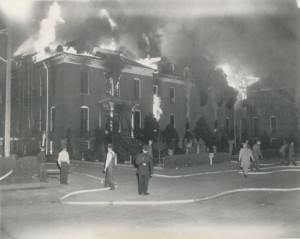 Much has been learned over the years about fire safety and about the things that can be extremely hazardous. Unfortunately, as with most things humans learn about, this information came at a price. Just before midnight on April 4, 1949, in Effingham, Illinois, at Saint Anthony’s Hospital, a fire broke out. I can’t imagine a worse place to have a fire, than a hospital or nursing home, because not everyone can just stand up and file out of the building in a safe and orderly fashion. In addition to that, there were not as many fire safety regulations in place back then. The resulting disaster caused the death of 74 people at the hospital.
Much has been learned over the years about fire safety and about the things that can be extremely hazardous. Unfortunately, as with most things humans learn about, this information came at a price. Just before midnight on April 4, 1949, in Effingham, Illinois, at Saint Anthony’s Hospital, a fire broke out. I can’t imagine a worse place to have a fire, than a hospital or nursing home, because not everyone can just stand up and file out of the building in a safe and orderly fashion. In addition to that, there were not as many fire safety regulations in place back then. The resulting disaster caused the death of 74 people at the hospital.
This fire became the example of the special hazards that hospitals can present for a fire disaster, and it was that reason for the regulations to be updated. The safety of the patients was paramount, and something had to  be done. The hospital was operated by the Sisters of Saint Francis, who lived at the convent next door to the hospital. The was constructed mainly out of wood and brick. It housed 100 beds. Parts of the building dated back to 1876. By 1949 the facility was completely outdated. It contained open corridors and staircases. Many walls and ceilings were covered with oilcloth fabrics and combustible soundproof tiles. The building lacked sprinklers, as well as fire detection and alarm systems. Because the hospital was built of wood and brick, and much of it was an open floor plan, there was little to stop the progression of the fire. The combustible building materials gave no resistance to the advancement of the flames.
be done. The hospital was operated by the Sisters of Saint Francis, who lived at the convent next door to the hospital. The was constructed mainly out of wood and brick. It housed 100 beds. Parts of the building dated back to 1876. By 1949 the facility was completely outdated. It contained open corridors and staircases. Many walls and ceilings were covered with oilcloth fabrics and combustible soundproof tiles. The building lacked sprinklers, as well as fire detection and alarm systems. Because the hospital was built of wood and brick, and much of it was an open floor plan, there was little to stop the progression of the fire. The combustible building materials gave no resistance to the advancement of the flames.
At the time of the fire, there were 116 patients and ten staff members were on duty. Many of them were trapped on the upper floors when the fire engulfed the lower floors. This number included eleven newborn infants and the nurse who stayed behind with them. A total of 74 people died, including patients, nurses, nuns, a priest and Frank Ries, the hospital superintendent who ran into the flames to try to rescue his wife. The Effingham Volunteer Fire Department, with its 26 men and three pumpers were fighting a losing battle. They simply didn’t have the resources they needed to put out a fire of this magnitude. Eleven other fire departments 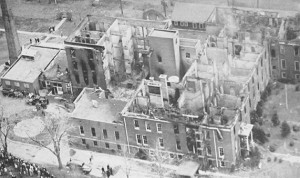 also responded. but little could be done.
also responded. but little could be done.
The cause was never determined, but investigators found many safety issues with the building. Something had to change. In response to the fire, Governor Adlai Stevenson ordered the evaluation of all the hospitals in the state to identify and mitigate fire hazards. The impact of the fire went beyond Illinois as hospitals across the United States made many of the fire protection improvements that are standard today. It is sometimes a matter of live and learn in this life, but it is very sad that it takes something as tragic as this to look into the possible fire hazards that can quickly end a life.
 I think that were it not for the danger involved, I could be a storm chaser. I love to watch the shows about storm chasers and about tornadoes themselves. I suppose the main reason I like those shows is that you can watch the awesomeness of nature’s storms, but you don’t really have to deal with the reality of the loss of life and damage to property. It seems more like a scene from a movie. Nevertheless, the reality is that in a real storm situation, tornadoes kill and they damage property. The first recognized storm chaser was David Hoadley, who began chasing North Dakota storms in 1956. Hoadley used data from area weather offices and airports to calculate the possible areas for tornadic activity. Hoadley is considered the pioneer storm chaser and was the founder of Storm Track magazine. With storms such as the Tri-State Tornado which occurred on this day, March 18, 1925, and many others that followed, I’m sure that Hoadley could see that there was a need for someone to find a way to predict the path of these deadly storms.
I think that were it not for the danger involved, I could be a storm chaser. I love to watch the shows about storm chasers and about tornadoes themselves. I suppose the main reason I like those shows is that you can watch the awesomeness of nature’s storms, but you don’t really have to deal with the reality of the loss of life and damage to property. It seems more like a scene from a movie. Nevertheless, the reality is that in a real storm situation, tornadoes kill and they damage property. The first recognized storm chaser was David Hoadley, who began chasing North Dakota storms in 1956. Hoadley used data from area weather offices and airports to calculate the possible areas for tornadic activity. Hoadley is considered the pioneer storm chaser and was the founder of Storm Track magazine. With storms such as the Tri-State Tornado which occurred on this day, March 18, 1925, and many others that followed, I’m sure that Hoadley could see that there was a need for someone to find a way to predict the path of these deadly storms.
The March 18, 1925 tornado traveled across the tri-state area of eastern Missouri, southern Illinois, and southern Indiana, killing 695 people, injuring some 13,000 people, and causing $17 million in property damage. It became known as the Tri-State Tornado, and it shocked the nation. The tornado first touched down in Ellington, Missouri at about 1:00pm, but the worst hit area was southern Illinois. More than 500 of the 695 people lost dies in Illinois, including 234 in the city of Murphysboro and 127 in West Frankfort.
In all, the Tri-State Tornado traveled 219 miles in it’s path of destruction, and was on the ground more than three hours. It ripped through 164 square miles and was more than a mile wide. It traveled at speeds of more than 70 miles per hour. There has never been a worse tornado in the history of the United States. Years after the Tri-State Tornado, scientists discovered the cyclic nature of tornado-producing thunderstorms. These 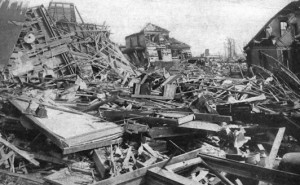 storms are able to produce one tornado after another, in a seemingly continuous damage path, that could easily be mistaken for a single tornado, when they were actually a family of tornadoes. Of course, with all the time that had passed, and the lack of things like Doppler Radar to see what the storm really was, it is nearly impossible to determine 91 years later whether or not the Tri-State tornado was one or a family of tornadoes, it remains in the history books as the longest-tracked and deadliest single tornado in recorded history. I have to wonder if David Hoadley, or someone like him had been able to predict these storms, maybe the loss of life would have been much lower.
storms are able to produce one tornado after another, in a seemingly continuous damage path, that could easily be mistaken for a single tornado, when they were actually a family of tornadoes. Of course, with all the time that had passed, and the lack of things like Doppler Radar to see what the storm really was, it is nearly impossible to determine 91 years later whether or not the Tri-State tornado was one or a family of tornadoes, it remains in the history books as the longest-tracked and deadliest single tornado in recorded history. I have to wonder if David Hoadley, or someone like him had been able to predict these storms, maybe the loss of life would have been much lower.
 These days, when a new president makes the move from their current home to the White House, it is a huge production. Very little of the packing is actually done by the first family. Things were much different in 1861, when President Abraham Lincoln was moving to Washington DC. When Abraham Lincoln moved to Washington DC, he packed his family’s belongings himself. His wife Mary was in Saint Louis on a shopping trip, so she would join him later in Indiana. It was on this day, February 11, 1861 that Abraham Lincoln boarded a two car private train…probably the only special thing about this transition. After an emotional speech to his fellow Springfield, Illinois citizens, Abraham Lincoln moved to Washington DC. The day was cold and rainy…much like the mood as Lincoln left his friends. He spoke to a crowd before departing: “Here I have lived a quarter of a century, and have passed from a young man to an old man. Here my children have been born, and one is buried. I now leave, not knowing when, or whether ever, I may return, with a task before me greater than that which rested upon Washington. Without the assistance of that Divine Being…I cannot
These days, when a new president makes the move from their current home to the White House, it is a huge production. Very little of the packing is actually done by the first family. Things were much different in 1861, when President Abraham Lincoln was moving to Washington DC. When Abraham Lincoln moved to Washington DC, he packed his family’s belongings himself. His wife Mary was in Saint Louis on a shopping trip, so she would join him later in Indiana. It was on this day, February 11, 1861 that Abraham Lincoln boarded a two car private train…probably the only special thing about this transition. After an emotional speech to his fellow Springfield, Illinois citizens, Abraham Lincoln moved to Washington DC. The day was cold and rainy…much like the mood as Lincoln left his friends. He spoke to a crowd before departing: “Here I have lived a quarter of a century, and have passed from a young man to an old man. Here my children have been born, and one is buried. I now leave, not knowing when, or whether ever, I may return, with a task before me greater than that which rested upon Washington. Without the assistance of that Divine Being…I cannot 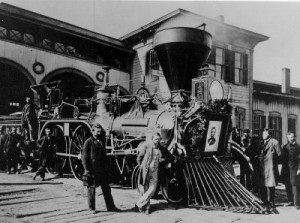 succeed. With that assistance, I cannot fail. To His care commending you, as I hope in your prayers you will commend me, I bid you an affectionate farewell.” One of the people who attended the speech, said that the president-elect’s “breast heaved with emotion and he could scarcely command his feelings.”
succeed. With that assistance, I cannot fail. To His care commending you, as I hope in your prayers you will commend me, I bid you an affectionate farewell.” One of the people who attended the speech, said that the president-elect’s “breast heaved with emotion and he could scarcely command his feelings.”
It’s hard to say if Lincoln had an inkling that he was not just saying “goodbye for now” to the citizens of Springfield, Illinois, or not, but there is no doubt that he knew that his presidency was going to be difficult…to say the least. Since his election, seven southern states has seceded from the Union. The nation was in the middle of a national crisis. President Lincoln knew that the nation was quite likely heading for a civil war. In short order, he was proven to be correct, when our nation embarked on one of the most bitter wars it ever fought…waged against its own people, over slavery.
When Lincoln said that it was possible that he would never return to Springfield, he was ironically very correct. 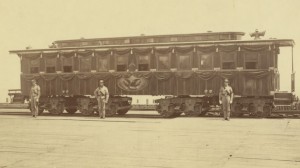 While he returned in body, he did not return in life…as we all know, because he was shot by John Wilkes Booth on April 14, 1865, and died at 7:22am the morning of April 15, 1865. Booth opposed Lincoln’s freeing of the slaves, and maybe felt like killing him would somehow change that. Of course, it did not. After his passing, Lincoln’s body made a two week train trip back to Springfield, Illinois for burial, taking a route that would allow the people to pay tribute along the way. Memorial services were held at different towns when the train passed through them. It was the only time he rode in the new private train car that had been built just for him.
While he returned in body, he did not return in life…as we all know, because he was shot by John Wilkes Booth on April 14, 1865, and died at 7:22am the morning of April 15, 1865. Booth opposed Lincoln’s freeing of the slaves, and maybe felt like killing him would somehow change that. Of course, it did not. After his passing, Lincoln’s body made a two week train trip back to Springfield, Illinois for burial, taking a route that would allow the people to pay tribute along the way. Memorial services were held at different towns when the train passed through them. It was the only time he rode in the new private train car that had been built just for him.
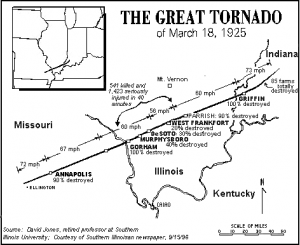 After writing about the worst winter ever, I began to look into other severe weather that made a big impact on a lot of lives, and might possibly have had an impact on my own family. I came across a tornado on this day, March 18, 1925 that was and still is the deadliest tornado in history. This tornado touched down at 1:00pm near Ellington, Missouri, and over the next 3 1/2 hours it tore across 3 states and 219 miles, finally ending up in Outsville, Indiana at 4:30 pm, where it hit one house and then dissipated. A tornado traveling this distance is virtually unheard of, but as we all know from this even…not impossible. This tornado was an F5 on the Fujita Scale. In all, the Tri-State Tornado, as it has since been called, hit more that 19 communities in Missouri, Illinois, and Indiana, while making an almost straight path across the 3 states.
After writing about the worst winter ever, I began to look into other severe weather that made a big impact on a lot of lives, and might possibly have had an impact on my own family. I came across a tornado on this day, March 18, 1925 that was and still is the deadliest tornado in history. This tornado touched down at 1:00pm near Ellington, Missouri, and over the next 3 1/2 hours it tore across 3 states and 219 miles, finally ending up in Outsville, Indiana at 4:30 pm, where it hit one house and then dissipated. A tornado traveling this distance is virtually unheard of, but as we all know from this even…not impossible. This tornado was an F5 on the Fujita Scale. In all, the Tri-State Tornado, as it has since been called, hit more that 19 communities in Missouri, Illinois, and Indiana, while making an almost straight path across the 3 states.
I don’t know if any of the 695 people who perished in the most deadly tornado in history, were related to me or not, but in studying my family history, I can say the I had family in those 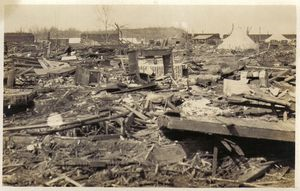 areas. In all likelihood, one or more of them were related, and when I think of the horror of their last moments, whether they were related or not…well, it is beyond horrible. In Missouri, 13 people lost their lives. In Illinois, 541 people lost their lives, with 234 in Murphysboro alone, which is a record for a single community, and there were 33 deaths at the De Soto school, which was a record for such a storm, and with only bombs and explosions taking higher school tolls. In Indiana 76 people lost their lives. The numbers are not exact. Some accounts say 630 and others say 689, while still others say 695. I find that in itself sad. It is always sad when lives lost go unaccounted for. In all, there were 2,027 injuries and 15,000 homes destroyed. I have been looking over the victims lists, and some of the last names are familiar to me, but I can’t say that these people were or were not related to me. Also, the lists that I found, were not complete lists. It may take a bit of
areas. In all likelihood, one or more of them were related, and when I think of the horror of their last moments, whether they were related or not…well, it is beyond horrible. In Missouri, 13 people lost their lives. In Illinois, 541 people lost their lives, with 234 in Murphysboro alone, which is a record for a single community, and there were 33 deaths at the De Soto school, which was a record for such a storm, and with only bombs and explosions taking higher school tolls. In Indiana 76 people lost their lives. The numbers are not exact. Some accounts say 630 and others say 689, while still others say 695. I find that in itself sad. It is always sad when lives lost go unaccounted for. In all, there were 2,027 injuries and 15,000 homes destroyed. I have been looking over the victims lists, and some of the last names are familiar to me, but I can’t say that these people were or were not related to me. Also, the lists that I found, were not complete lists. It may take a bit of 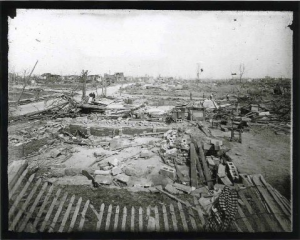 research to know for sure.
research to know for sure.
It doesn’t really matter whether I am related to any of the victims or not, the reality of this kind of devastation is beyond horrible. Of the 19+ communities, 5 were virtually destroyed along with more than 85 farms. I did find out that at the time of the Tri-State Tornado, my great great grandmother was living just 36 miles north of its path. One of the names might have been a cousin or nephew. Even knowing there is a possibility makes me sad. It is very hard to think about the family members of the victims who are left behind.

